| Francis Hague, Quaker Farmer (1701-1780) |
|
by Debbie Robison January 17, 2021 |
|
Francis Hague, a Pennsylvania Quaker, had a role in the early settlement of present-day Loudoun county when land was wooded and roads were few. In 1742 at age 31, he came to Virginia to obtain a land grant for 692 acres on Sycolin Creek, just south of present-day Leesburg.[1] When fellow Quaker Amos Janney surveyed the tract for him, Hague was a member of the survey team as the “marker.” He carved initials into trees at boundary corners, including two black oak trees that he marked with his own initials FH.[2] The following year, Hague purchased 303 acres on the South Fork of Catoctin at present-day Waterford where he resided.[3]
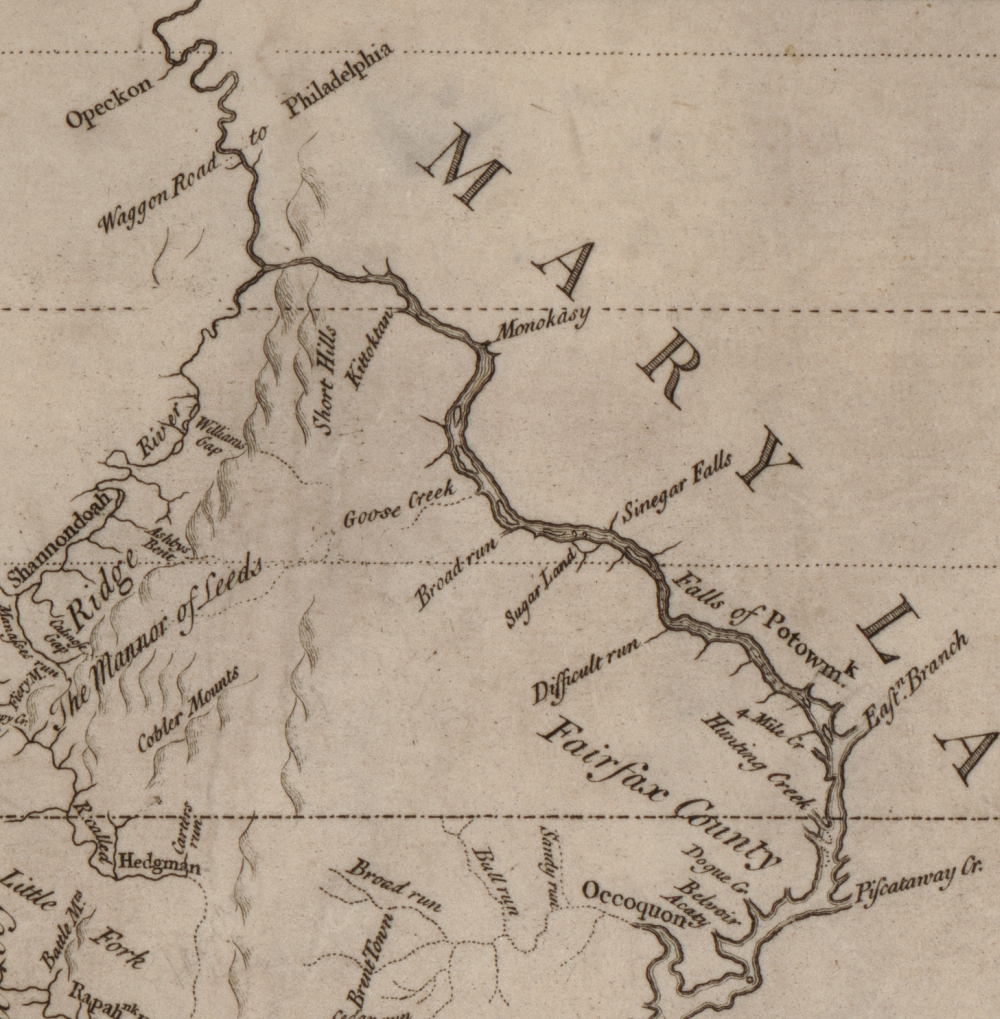
A survey of the northern neck of Virginia, surveyed 1736 & 1737, published ca 1747, John Warner, Image Courtesy Library of Congress, Click on Map for Larger Image
×
Hague was a successful man who held leadership roles in his religious Quaker community. He was also appointed a town trustee, along with other notable men of the day, when Leesburg was formed in 1758.[4] He and his near neighbor, John Hough, were in business together. In 1752, they were the first to purchase lot #84 on Duke and Royal Streets in the newly-formed town of Alexandria, though what they did with the lot is unknown.[5] That same year, the county court ordered Hough and Hague to measure and point out a place to build a bridge over Broad Run.[6] The court had the men inspect the bridge the following year to determine if it was built according to the agreement, if it was necessary to lengthen the bridge, and whether the county should pay for it.[7] The Loudoun County court appointed John Hough and Francis Hague as beef, tar pitch, turpentine, and flour inspectors for the county in 1758.[8] Hague was also called upon by the court, along with other respected men of the day, to determine the best routes for new roads.[9] |
| OCCUPATION |
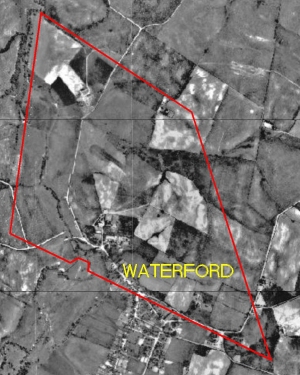
Francis Hague's 303-acre farm, approximate boundary in 1743, Shown over 1937 USDA Aerial Photo, Photo Courtesy Loudoun County Farming was Hague’s principal occupation. In 1765, Hague owned 950 acres of land.[10] He may have cultivated tobacco in his earlier years in Loudoun County, but by 1780 he was growing wheat, rye, oats, and hay in farm fields, and raising cattle, sheep, geese, and hogs. His farm produced items for home use, such as honey made by his swarm of bees and wool sheared from his sheep and spun on his spinning wheel. The cider funnel, stills, and kegs he owned suggests that the farm produced hard cider and distilled liquor.[11] Quakers, members of the Society of Friends, ensured that their membership followed guidance issued at yearly meetings. During most of Hague’s lifetime, this guidance discouraged the disorderly practice of drinking to excess.[12] It wasn’t until a temperance movement, begun about 1776 during the American Revolutionary War, that the Society discouraged drinking any distilled liquor (ardent spirits as it was called back then).[13] This may explain why Hague possessed two stills, a still worm, and eleven still tubs, because for most of his life it was permissible to drink ardent spirits, just not to excess.[14] |
| LABOR |
|
No doubt Hauge’s numerous offspring helped around the household and farm, yet he supplemented this help in three ways. Firstly, he had an African American man, Isaac, in his household from at least 1758 to 1765.[15]By 1758, the Society of Friends began discouraging its members from enslaving people.[16] This came about after some Quaker pioneers were captured and enslaved by indigenous people. Reflection on this experience resulted in adherence to the precept, To do unto others as we would they should do unto us.[17] It is not known what role Isaac had in the household. Hague was not chastised by the Society for having him in his household as some other members were for owning slaves. Secondly, Hague purchased the indenture of a convict transported to America. Convicts came to the northern neck of Virginia by the tens of thousands prior to the American Revolutionary War.[18] Christopher Fiddes, an Irish convict, was sentenced in 1758 to 14 years transportation.[19] Fiddes first appears in Hague’s household in 1769, suggesting that Hague purchased the servant’s indenture from someone else when Fiddes still had three years left to work on his indenture. Hague’s purchase doesn’t appear to have been a wise move. In August of that same year, Fiddes was sentenced to 25 lashes on his bare back at the public whipping post for gambling in a public house contrary to law.[20] Three months later, Hague published a reward advertisement for the return of Fiddes who ran away. The text of the advertisement is interesting. Apparently, Fiddes was wearing two sets of clothes. It would have been suspicious had he carried a spare change of clothes in a sack. Fiddes may have made a clean getaway as he never appeared in Hague’s household again. RUN away from the subscriber, living in Loudoun county, near the Quakers meetinghouse, about 12 miles below the Blue Ridge, an Irish convict servant man named Christopher Fiddes, about 5 feet 9 or 10 inches high, and pretty well set: He had on when he went away a light coloured linsey jacket, a cotton ditto, a felt hat, two homespun shirts patched on the pack with new linen, two pair of trowsers home made, a good pair of strong shoes, and a large flag handkerchief. He is very talkative, and of a very proud bold behaviour, very near sighted, is a lover of strong drink, and very subject to take too much when opportunity offers, and is then very ill behaved; he walks briskly but heavy, taking long steps with a proud air, and is subject to set his hands on his sides when speaking to any person; has a down look, and is marked with the small-pox; tho’ not deep, put plainly see. Any person taking up and securing the said servant, so that he may be had again, shall have a reward of THREE POUNDS, with all reasonable charges, paid by FRANCIS HAGUE.[21] Thirdly, Amos Hague, age about 18 years, was bound to Francis Hague by the county court in 1773 to be brought up as a farmer.[22] |
| RESIDENCE |
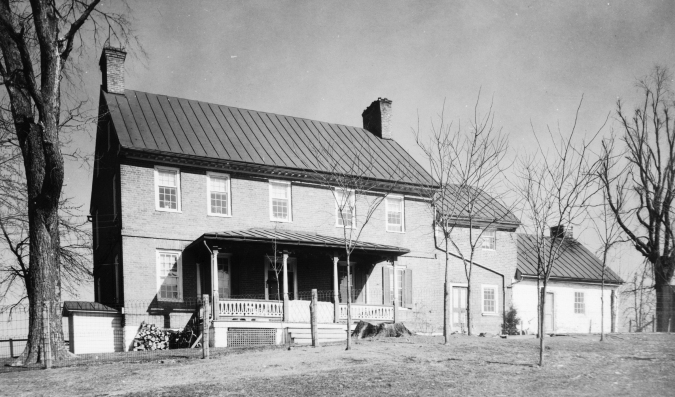
Francis Hague House and Kitchen (center portion is a later addition), HABS Photo, ca. 1930s, Image Courtesy Library of Congress Hague lived in a handsome Georgian-style brick house on a hill overlooking the South Fork of Catoctin Creek. His kitchen, with a large fireplace for cooking, was in a separate stone building near the house. The house was filled with furniture including four bedsteads, two tables, one armed chair and seven other chairs, a desk, two chests, and a chest of drawers. One of the tables may have been in the kitchen.[23] The house and other buildings on Hague’s farm were quite valuable. His home, in keeping with his status as a successful and prominent citizen, was one of the larger houses in the county. After his death, his 406-acre property was sold for £900. At that time, land was selling for about £1/acre; therefore, the value of his buildings upon the land was about £494. The medium value of buildings sold at that time was about £121, so you can see that his buildings were quite substantial in comparison.[24] 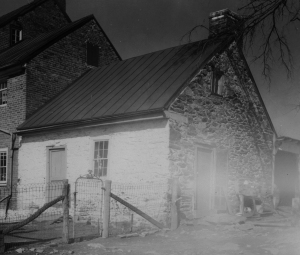
Francis Hague's Kitchen 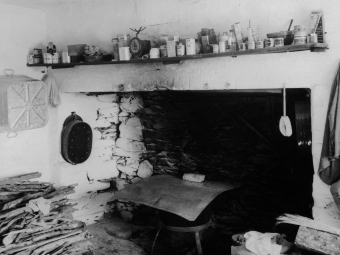
Francis Hague's Kitchen Fireplace |
| BEGINNING OF A COMMUNITY |
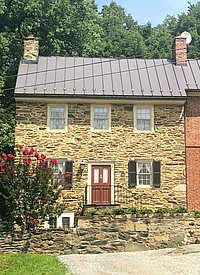
Thomas Hague's House, ca. 1772 A center of activity began to develop in the area of present-day Waterford after Francis Hague sold land to Mahlon Janney for a gristmill and sawmill in 1762.[25] Ten years later, Francis Hague sold land near the mill to his son, Thomas, where Thomas built a stone house.[26] Thomas moved out of his father’s household in 1772.[27] When Thomas sold his land to Joseph Janney in 1781, this set into motion the future development of the village of Waterford.[28] Both the Francis Hague house and Thomas Hague house still exist at the village today. |
| ENDNOTES |
|
[1] Francis Hague birth record, U.S. Quaker Meeting Records, 1681-1935, Pennsylvania, Bucks, Falls Monthly Meeting, Falls Copy Births, Deaths and Marriages, as viewed at https://www.ancestry.com/ Also, Francis Hague and family request for Certificate from Quaker Falls Monthly Meeting to remove to Prince William County, Virginia, March 2, 1742, U.S., Quaker Meeting Records, 1681-1935, Pennsylvania, Bucks, Falls Monthly Meeting, Minutes, 1731-1767, as viewed at https://www.ancestry.com/ [2] Northern Neck Land Grants E, 1736-1742, p. 519, 2 November 1742; Virginia State Land Office Northern Neck Surveys Reel No. 8; as viewed at https://www.lva.virginia.gov/ [3] Deed from John Mead to Francis Hague, Fairfax County Deed Book A1, p. 282 (FXDB A1(1)282), March 19, 1743, Fairfax County Court Records, Fairfax, Virginia. [4] U.S., Quaker Meeting Records, 1681-1935, Virginia, Loudoun, Fairfax Monthly Meeting, Minutes, 1776-1802 as viewed at https://www.ancestry.com/ ; Town of Leesburg formed, Hening’s Statutes at Large, Volume 7, Chapter III, p. 234, as viewed at http://vagenweb.org/hening/vol07-12.htm [5] Deed from Town of Alexandria Trustees to John Hough and Francis Hague, FX DB C1(3)382, September 20, 1752, Fairfax County Court Records, Fairfax, Virginia. [6] Duncan, Patricia B., “Fairfax County Virginia 1749-1808 Minute and Order Books ” Heritage Books, Berwyn Heights, MD, 2013, Fairfax County Court Order Book 1749-1754, p. 196, May 21, 1752. [7] Duncan, Patricia B., “Fairfax County Virginia 1749-1808 Minute and Order Books ” Heritage Books, Berwyn Heights, MD, 2013, Fairfax County Court Order Book 1749-1754, p. 443, August 23, 1753. [8] Duncan, Patricia B., “Loudoun County Virginia Order Books A-I 1757-1786,” Heritage Books, Westminster, MD, 2007, Loudoun County Court Order Book A, p. 77, March 15, 1758. [9] Duncan, Patricia B., “Loudoun County Virginia Order Books A-I 1757-1786,” Heritage Books, Westminster, MD, 2007, Loudoun County Court Order Book A:159, September 12, 1758; Also Loudoun County Court Order book D:332, April 10, 1770. [10] Hiatt, Marty, and Craig R. Scott. Loudoun County,
Virginia Tithables, 1758-1786. Athens, Ga:
Iberian Pub. Co, 1995. Print. [11] Francis Hague Estate Inventory, Loudoun County Will Book B:387, November 27, 1780, Loudoun County Circuit Court. Note: The inventory included old hogsheads, typically used to transport tobacco to port. [12] U.S., Quaker Meeting Records, 1681-1935, Virginia, Loudoun, Fairfax Monthly Meeting, Minutes, 1746-1776 as viewed at https://www.ancestry.com/ ; Joseph Hollingsworth, March 2, 1747. [13] Burrows, Edith C., “The moderate period of the Temperance reform, 1776-1833,” (1966), Honors Theses, Paper 334, as viewed at https://scholarship.richmond.edu/cgi/viewcontent.cgi?article=1330&context=honors-theses; Also, U.S., Quaker Meeting Records, 1681-1935, Virginia, Loudoun, Fairfax Monthly Meeting, Minutes, 1776-1802 as viewed at https://www.ancestry.com/ ; May 22, 1779 [14] Francis Hague Estate Inventory, Loudoun County Will Book B:387, November 27, 1780, Loudoun County Circuit Court. [15] Hiatt, Marty, and Craig R. Scott. Loudoun County, Virginia Tithables, 1758-1786. Athens, Ga: Iberian Pub. Co, 1995. Print. [16]Ancestry.com. U.S., Quaker Meeting Records, 1681-1935 [database on-line]. Provo, UT, USA: Ancestry.com Operations, Inc., 2014. Source material: Swarthmore, Quaker Meeting Records. Friends Historical Library, Swarthmore College, Swarthmore, Pennsylvania. Philadelphia Yearly Meeting, 1758. [17]Ancestry.com. U.S., Quaker Meeting Records, 1681-1935 [database on-line]. Provo, UT, USA: Ancestry.com Operations, Inc., 2014. Source material: Swarthmore, Quaker Meeting Records. Friends Historical Library, Swarthmore College, Swarthmore, Pennsylvania. Philadelphia Yearly Meeting, 1758. [18] Coldham, P. Wilson. (1993). The complete book of emigrants, 1751-1776: a comprehensive listing compiled from English public records of those who took ship to the Americas for political, religious, and economic reasons; of those who were deported for vagrancy, roguery, or non-conformity; and of those who were sold to labour in the new colonies. Baltimore, Md.: Genealogical Publishing. Also, Lilly, Thomas. Irish Convicts, Virginia Gazette, 11 Feb 1773, p. 4. [19] Ancestry.com. Emigrants in Bondage, 1614-1775 [database on-line]. Lehi, UT, USA: Ancestry.com Operations, Inc., 2016. From: Coldham, Peter Wilson. The Complete Book of Emigrants in Bondage, 1614-1775. Baltimore, MD, USA: Genealogical Publishing Co., 1988. [20] Duncan, Patricia B., “Loudoun County Virginia Order Books A-I 1757-1786,” Heritage Books, Westminster, MD, 2007, Loudoun County Court Order Book D:249, August 15, 1769. [21] Hague, Francis. Virginia Gazette, 09 Nov 1769, p. 4., col. 2, as viewed at https://research.colonialwilliamsburg.org/DigitalLibrary/va-gazettes/ [22] Duncan, Patricia B., “Loudoun County Virginia Order Books A-I 1757-1786,” Heritage Books, Westminster, MD, 2007, Loudoun County Court Order Book F:181, September 13, 1773. [23] Francis Hague Estate Inventory, Loudoun County Will Book B:387, November 27, 1780, Loudoun County Circuit Court. [24] Calculations based on deed information in Loudoun County Deed Books P and Q, 1785-1788. [25] Deed from Francis Hague to Mahlon Janney, Loudoun County Deed Book C:367, June 14, 1762. [26] Deed from Francis Hague to Thomas Hague, Loudoun County Deed Book I:168, March 19, 1773. [27] Hiatt, Marty, and Craig R. Scott. Loudoun County, Virginia Tithables, 1758-1786. Athens, Ga: Iberian Pub. Co, 1995. Print. [28] Deed from Thomas Hague to Joseph Janney, Loudoun County Deed Book O:9, May 1, 1781. |

| Home |
 |